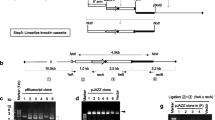Abstract
Suppression analysis is used for the identification of new genes and genetic interactions when there is a notable phenotype available for genetic selection or screening. A random genomic DNA library constructed on a multi-copy plasmid is a useful tool for suppression analysis when one expects that an overdose of a few genes will suppress the phenotype. These libraries have been successfully used to determine the function of a gene by revealing genes whose functions are related to the gene of interest. They have also been used to identify the targets of chemical or biological agents by increasing the number of unaffected target gene products in a cell. In this article, I will discuss important considerations for constructing multicopy genomic DNA libraries. The protocol provided in this paper should be a useful guide for constructing genomic DNA libraries in many bacterial species for which multi-copy plasmids are available.
Similar content being viewed by others
References
Bae, S., Mueller, O., Wong, S., Rawls, J.F., and Valdivia, R.H. 2016. Genomic sequencing-based mutational enrichment analysis identifies motility genes in a genetically intractable gut microbe. Proc. Natl. Acad. Sci. USA113, 14127–14132.
Bola, G. 2005. Evaluating the role of G, C-nucleotides and length of overhangs in T4 DNA ligase efficiency. J. Exp. Microbiol. Immunol.8, 1–7
Chamakura, K.R., Sham, L.T., Davis, R.M., Min, L., Cho, H., Ruiz, N., Bernhardt, T.G., and Young, R. 2017. A viral protein antibiotic inhibits lipid II flippase activity. Nat. Microbiol.2, 1480–1484.
Cho, S.H., Szewczyk, J., Pesavento, C., Zietek, M., Banzhaf, M., Roszczenko, P., Asmar, A., Laloux, G., Hov, A.K., and Leverrier, P., et al. 2014a. Detecting envelope stress by monitoring β-barrel assembly. Cell159, 1652–1664.
Cho, H., Uehara, T., and Bernhardt, T.G. 2014b. Beta-lactam antibiotics induce a lethal malfunctioning of the bacterial cell wall synthesis machinery. Cell159, 1300–1311.
Gardner, K.A.J.A., Osawa, M., and Erickson, H.P. 2017. Whole genome re-sequencing to identify suppressor mutations of mutant and foreign Escherichia coli FtsZ. PLoS One12, e0176643.
Gropp, M., Strausz, Y., Gross, M., and Glaser, G. 2001. Regulation of Escherichia coli RelA requires oligomerization of the C-terminal domain. J. Bacteriol.183, 570–579.
Hamer, L., DeZwaan, T.M., Montenegro-Chamorro, M.V., Frank, S.A., and Hamer, J.E. 2001. Recent advances in large-scale transposon mutagenesis. Curr. Opin. Chem. Biol.5, 67–73.
Koo, J.T., Choe, J., and Moseley, S.L. 2004. HrpA, a DEAH-box RNA helicase, is involved in mRNA processing of a fimbrial operon in Escherichia coli. Mol. Microbiol.52, 1813–1826.
Lai, G.C., Cho, H., and Bernhardt, T.G. 2017. The mecillinam resistome reveals a role for peptidoglycan endopeptidases in stimulating cell wall synthesis in Escherichia coli. PLoS Genet.13, e1006934.
Li, X., Zolli-Juran, M., Cechetto, J.D., Daigle, D.M., Wright, G.D., and Brown, E.D. 2004. Multicopy suppressors for novel antibacterial compounds reveal targets and drug efflux susceptibility. Chem. Biol.11, 1423–1430.
Nichols, B.P., Shafiq, O., and Meiners, V. 1998. Sequence analysis of Tn10 insertion sites in a collection of Escherichia coli strains used for genetic mapping and strain construction. J. Bacteriol.180, 6408–6411.
Rockabrand, D. and Blum, P. 1995. Multicopy plasmid suppression of stationary phase chaperone toxicity in Escherichia coli by phosphogluconate dehydratase and the N-terminus of DnaK. Mol. Gen. Genet.249, 498–506.
Singer, M., Baker, T.A., Schnitzler, G., Deischel, S.M., Goel, M., Dove, W., Jaacks, K.J., Grossman, A.D., Erickson, J.W., and Gross C.A. 1989. A collection of strains containing genetically linked alternating antibiotic resistance elements for genetic mapping of Escherichia coli. Microbiol. Rev.53, 1–24.
Singh, S.K., SaiSree, L., Amrutha, R.N., and Reddy, M. 2012. Three redundant murein endopeptidases catalyse an essential cleavage step in peptidoglycan synthesis of Escherichia coli K12. Mol. Microbiol.86, 1036–1051.
Ueguchi, C. and Ito, K. 1992. Multicopy suppression: an approach to understanding intracellular functioning of the protein export system. J. Bacteriol.174, 1454–1461.
Yunck, R., Cho, H., and Bernhardt, T.G. 2015. Identification of MltG as a potential terminase for peptidoglycan polymerization in bacteria. Mol. Microbiol.99, 700–718.
Acknowledgements
This work was supported by the National Research Foundation of Korea (NRF) Grant (NRF-2019R1A2C1002648).
Author information
Authors and Affiliations
Corresponding author
Rights and permissions
About this article
Cite this article
Cho, H. Construction of a multicopy genomic DNA library and its application for suppression analysis. J Microbiol. 57, 1041–1047 (2019). https://doi.org/10.1007/s12275-019-9417-8
Received:
Revised:
Accepted:
Published:
Issue Date:
DOI: https://doi.org/10.1007/s12275-019-9417-8




